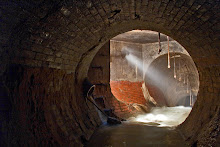I want to consider with you the genre of this Canadian novel. I think the novel for a number of reasons, which I shall go on to discuss, can be considered a work of post-modern fiction.
I am aware it is very difficult to define post-modernism completely because the boundaries of literary genres are very blurred. Post-modernism destabalises a literary genre, in this case the Candian. It goes against the traditional narrative stuctures and expected themes of the modern, and I would argue that In the Skin of a Lion is a good example of this.
The focus upon the lost histories of those who built the bridge is the first initial example that comes to mind. Ondaatje focuses upon the men who lost their lives building the bridge- rather that the corporate insitues who commission the building. The viaduct is a significant and impressive piece of architecture built in the 1930's but what it stands for and the history behind it its clearly separated by Ondaatje; he gives a voice to the workers, and draws attention to what preferably would be forgotten. As we have discussed in out seminars history is not stable, therefore the recollection of history can be retold from may different perspectives. Evidently the author takes a refereshing angle upon the construction of history. The extract beginning on the bottom of page 28 to 29 seems to be a combination of immagination/observation/history. It makes the contemporary reader consider if the location of the bridge and the names of the surrounding streets are historically acurate? Was the bridge completed 18th Oct 1918? If the streets were planked in 1910? etc. elements of historcal fact/fiction are then combines with a vivid decription of The smell of tar seeps through the porous body of their clothes. The comination of the two creates an exiting novel combining history with imagination. (Consider the paradox between the aesthetic and the historical) plus we must always bare in mind that our own knowledge and perception affects the way we read a text too.
Stepping away from the content the novel can also be considered to be postmodern in view of its stucture and lay out. The novel jumps through elements of time effortlessly in the seven sections of the book. the temporal, spacial and symbolic ordering in post-modernism is a conscious one, made evident to the reader. Although this is not the case throughout the entire novel- in a majority of it the novel is constructed in alternating topics- between character development and relationships, into the wider sphere encompassing Canadian history, landscapes and heritage, with less, if any, direct speech and quotation.
Subscribe to:
Post Comments (Atom)

1 comment:
Your point that ‘we must always bear in mind that our own knowledge and perception affects the way we read a text too’ is illustrated by Danni’s point about the different narrative voices describing Nicholas Temelcoff. Is there some textual detail you can point to in your extract that makes the point as well?
You mention ‘the paradox between the aesthetic and the historical’ – what is this? Can you say more about it? (I suspect this will come up when we look at Fugitive Pieces.)
Also - I wouldn’t call Canadian literature a genre – genres cover categories like detective fiction/epic poems/tragedies rather than national literatures.
Post a Comment